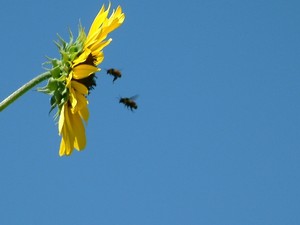11 Feb Wed 2009
Good Luck to the New Guy
The hens give him no respect. He can’t get the time of day from anyone except the baby birds. What a misundestood rooster! He sings a lot in a sad, proud sort of way, clucking and chuckling with disgruntlement even as he sings the head-rooster song. He can’t get no respect. We’re calling him Rodney.
Scuttle let him become head rooster without a fight the moment he was introduced to the flock. Too many hens for Scuttle. Good luck to the new guy.
In the first photo is the second of our 3 new roosters. He and his brother are almost identical - black and white and very large. Though younger than the other birds, they are much larger. Large and mel-low!
Pro-Cage is Pernicious Piffle
Add it up and compare for your self.
OUTSIDE CAGES (grazing)
FEED (per bird/year) - $78 (high estimate, based on increasing feed prices)
INSIDE CAGES
FEED (per bird/year) - $208 (same high estimate)
Housing can be held constant because grazing birds still need a coop at night.
Heat and other environmental care in California simply doesn’t matter much unless you’re trying to force production, in which case it would be constant whether the birds grazed or not.
Mortality rate for grazing birds may get as high as 1% per year under normal conditions if roosters are employed, and if hormones are NOT used. This rate is not different from those experienced by cage conditions and reflects the skills of good scientific management. The cost of 1/3 roosters in the flock increases feed costs, but that is accounted for above.
Discussion:
After hearing so many other producers bemoan the condition of the State, we had to point out that this is perhaps one of the kindest things the State has ever done for an agricultural industry.
To serve the consumer, farmers have to know what the consumer wants. So often it is a challenge to understand exactly what the consumer desires. The loud and clear message is a signal: and when, by our experience, the cost of producing eggs is cheaper when the animals are outside cages than within, we couldn’t be happier.
If the State were asking something onerous, we might object. But to be requierd to produce a product that costs less to make and is in higher demand is no hardship. We suspect those producers who object loudest either do not know how to produce eggs without cages, and would make ourselves available to any chicken farmer who wants to learn how to adapt to the new, good law.
If the larger producers cannot, there are many smaller producers who can. This will result in greater employment because of a demonopolization of the industry. Chicken farming is already a thriving hobby among enthusiasts, and as the larger producers find themselves unable to adapt to market demands, these enthusiasts will become tomorrow’s leaders. These enthusiasts are usually amateurs, recently consumers, and are attuned to the demands of the market.
As professional farmers, we’re proud to stand among these amateurs as their body of experience proves itself useful to California.

